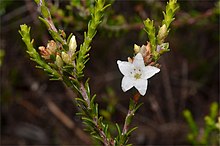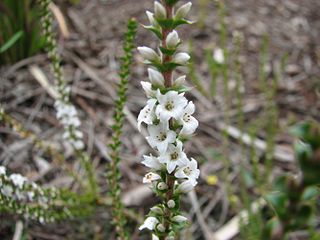
Epacris gunnii is a species of flowering plant in the family Ericaceae and is endemic to south-eastern Australia. It is an erect shrub with hairy branchlets, concave, sharply-pointed, broadly egg-shaped leaves, and tube-shaped, white flowers arranged along the stems.

Bossiaea cordigera , commonly known as wiry bossiaea, is a species of flowering plant in the family Fabaceae and is endemic to southern Australia. It is a straggling shrub with wiry branches, egg-shaped to more or less heart-shaped leaves and yellow and red flowers.
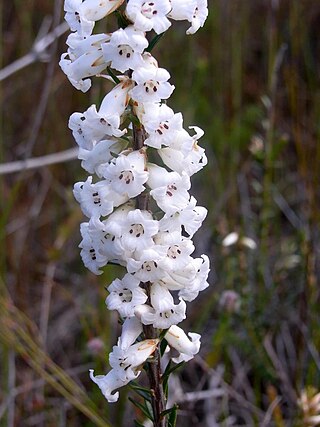
Epacris obtusifolia, commonly known as blunt-leaf heath, is a species of flowering plant from the heath family, Ericaceae, and is endemic to eastern Australia. It is an erect shrub with few stems, crowded, oblong to elliptic leaves and tube-shaped white or cream-coloured flowers arranged along the stems.
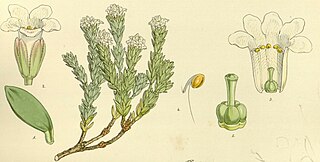
Archeria serpyllifolia is a dense, compact, low growing shrub, that is endemic to Tasmania, Australia, inhabiting the undisturbed alpine areas of southern and south-west Tasmania. This plant is commonly referred to by Australasian naturalists as thyme archeria.
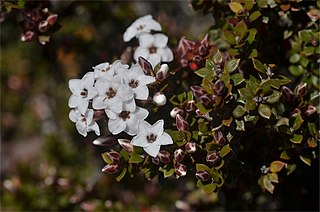
Epacris serpyllifoliais a species of flowering plant in the heath family Ericaceae and is endemic to Tasmania. It is a small low-lying or weakly erect shrub with heart-shaped to broadly egg-shaped leaves and tube-shaped white flowers crowded in upper leaf axils.
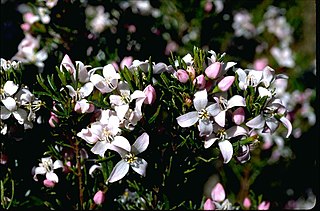
Boronia citriodora, commonly known as lemon-scented boronia, lemon plant or lemon thyme, is a woody shrub that is endemic to Tasmania. It has pinnate leaves and white to pink flowers that are arranged singly or in groups of up to seven, in the leaf axils or on the ends of the branches.
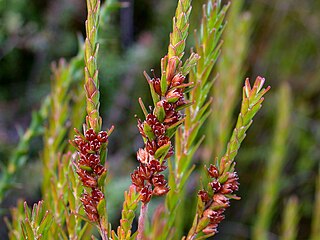
Epacris corymbiflora is a species of flowering plant in the heath family, Ericaceae, and is endemic to Tasmania. It is a low, spreading shrub with elliptic leaves and white, tube-shaped flowers.
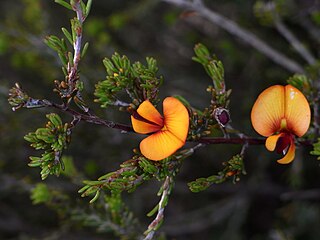
Pultenaea prostrata, commonly known as silky bush-pea, is a species of flowering plant in the family Fabaceae and is endemic to south-eastern Australia. It is a small, rigid, wiry, low-lying or prostrate shrub with cylindrical leaves, and yellow, red and purple-brown flowers.
Epacris apsleyensis is a species of flowering plant in the heath family Ericaceae and is endemic to a small area of Tasmania. It is an erect shrub with hairy branchlets, lance-shaped to elliptic leaves and tube-shaped flowers with white petals.

Epacris celata is a species of flowering plant in the heath family Ericaceae and is endemic to south-eastern continental Australia. It is a spreading to erect shrub with flat, elliptic to egg-shaped leaves with the narrower end towards the base, and tube-shaped white flowers clustered in upper leaf axils.

Epacris franklinii is a species of flowering plant in the heath family, Ericaceae, and is endemic to Tasmania. It is an erect, spreading shrub with lance-shaped or elliptic leaves and white, tube-shaped flowers.

Epacris glabella, commonly known as smooth heath, is a species of flowering plant in the heath family, Ericaceae, and is endemic to Tasmania. It is a shrub with erect branches, egg-shaped to elliptic leaves and white, tube-shaped flowers.
Epacris grandis, commonly known as grand heath or tall heath, is a species of flowering plant in the heath family Ericaceae and is endemic to a small area of Tasmania. It is a robust, erect shrub with smooth stems, lance-shaped leaves and tube-shaped flowers with white petals.
Epacris lithophila is a species of flowering plant in the heath family Ericaceae and is endemic to a small area of New South Wales. It is an erect shrub with few branches, lance-shaped to elliptic leaves and creamy-white, tube-shaped flowers.
Epacris moscaliana, commonly known as seepage heath, is a species of flowering plant in the heath family Ericaceae and is endemic to Tasmania. It is a bushy shrub with wand-like branches, narrowly lance-shaped to egg-shaped or round leaves, and bell-shaped white flowers in clusters at the ends of the branches.

Epacris mucronulata is a species of flowering plant in the heath family Ericaceae and is endemic to Tasmania. It is an erect shrub with softly-hairy young branches, lance-shaped leaves, and cylindrical white flowers in small groups at the ends of the branches.

Epacris paludosa, commonly known as swamp heath, is a species of flowering plant from the heath family, Ericaceae, and is endemic to eastern Australia. It is an erect, bushy shrub with lance-shaped, elliptic or egg-shaped leaves and tube-shaped white or cream-coloured flowers in crowded, leafy heads at the ends of branches.
Epacris rigida is a species of flowering plant in the family Ericaceae and is endemic to eastern New South Wales. It is an erect, bushy shrub with elliptic leaves and white or cream-coloured, tube-shaped flowers.

Epacris tasmanica is a species of flowering plant in the heath family Ericaceae and is endemic to Tasmania. It is an erect shrub with lance-shaped leaves and tube-shaped white flowers crowded in upper leaf axils.

Cryptandra alpina, commonly known as alpine pearlflower, is a species of flowering plant in the family Rhamnaceae and is endemic to Tasmania. It is a small, prostrate shrub with slender branches, linear leaves, and tube-shaped white flowers arranged singly on the ends of branches.
